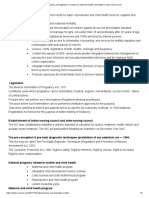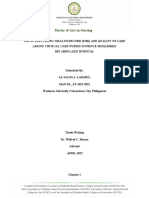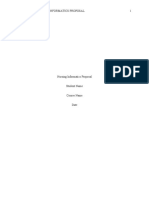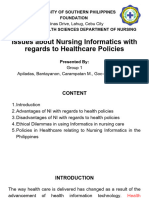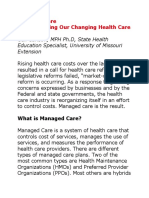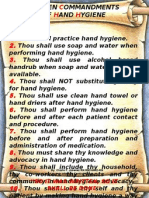0 ratings0% found this document useful (0 votes)
2 viewsNursing in Informatics Technology: Utilizing Electronic Health Records
Nursing in Informatics Technology: Utilizing Electronic Health Records
Uploaded by
najd81almutairiCopyright:
© All Rights Reserved
Available Formats
Download as DOCX, PDF, TXT or read online from Scribd
Nursing in Informatics Technology: Utilizing Electronic Health Records
Nursing in Informatics Technology: Utilizing Electronic Health Records
Uploaded by
najd81almutairi0 ratings0% found this document useful (0 votes)
2 views2 pagesOriginal Title
1
Copyright
© © All Rights Reserved
Available Formats
DOCX, PDF, TXT or read online from Scribd
Share this document
Did you find this document useful?
Is this content inappropriate?
Copyright:
© All Rights Reserved
Available Formats
Download as DOCX, PDF, TXT or read online from Scribd
Download as docx, pdf, or txt
0 ratings0% found this document useful (0 votes)
2 views2 pagesNursing in Informatics Technology: Utilizing Electronic Health Records
Nursing in Informatics Technology: Utilizing Electronic Health Records
Uploaded by
najd81almutairiCopyright:
© All Rights Reserved
Available Formats
Download as DOCX, PDF, TXT or read online from Scribd
Download as docx, pdf, or txt
You are on page 1of 2
Nursing in Informatics Technology: Utilizing Electronic Health Records
Recently, the nursing sector has experienced a major evolution by
utilizing informatics technology, specifically by incorporating Electronic
Health Records (EHRs). Electronic Health Records (EHRs) are electronic
versions of patients' physical charts and include detailed information
on patients' medical history, treatments, and care plans. The transition
from using paper records to utilizing EHRs has transformed the way
nurses record patient data, collaborate with healthcare professionals,
and enhance patient care results.
One major advantage of EHRs is the improved availability of patient
data. Accessing a patient's chart in traditional paper records can be
time-consuming and complex, particularly during emergencies. EHRs
enable nurses to readily retrieve patient information from anywhere in
a healthcare setting. This instantaneity assists in work efficiency and
also enables quick decision-making, potentially enhancing patient
results. For example, when a nurse is responsible for giving
medication, they can quickly check allergen history and previous
reactions in real-time to guarantee patient safety.
Additionally, electronic health records help improve communication
between healthcare professionals. Through a centralized digital
platform, nurses can easily communicate patient information with
doctors, specialists, and other healthcare team members. This
interconnectedness encourages collaboration across disciplines,
enabling a more holistic approach to patient care. Sophisticated EHR
systems frequently have functions like secure messaging and
notifications for important health updates, allowing for faster reactions
to potential health emergencies.
The use of EHRs has also led to enhancements in how documentation
is done. Nurses can use standardized templates in EHRs to ensure
consistent and accurate record-keeping. Standardizing the notes
reduces the chance of mistakes like misinterpretation and illegibility
often seen with handwritten notes. Moreover, electronic health records
aid evidence-based practice for nurses by granting them access to
current clinical guidelines and research sources. This accessibility
assists nurses in making well-informed care decisions and improves
the quality of nursing practices.
In spite of these benefits, the shift to electronic health records comes
with difficulties. One common obstacle is the steep learning curve that
comes with using new technology. Numerous nurses might experience
feelings of being overloaded by the intricacies of EHR systems,
resulting in frustration and reduced efficiency. Healthcare institutions
must prioritize investing in thorough training initiatives to ensure
nursing staff can master the efficient use of EHR systems.
Furthermore, continuous technical assistance is essential in order to
resolve any issues that may occur during regular utilization.
Another issue is the worry about patient confidentiality and protection
of data. The digitalization of sensitive health data has increased the
urgency of addressing the risk of data breaches and cyber-attacks.
Nurses need to make sure they give importance to keeping patient
data confidential and secure when using EHR systems. The importance
of following regulations like HIPAA to protect patient information is
stressed by this necessity.
In summary, Electronic Health Records are a major improvement in
nursing informatics technology, greatly impacting how nurses handle
patient data and work with healthcare teams. The positive effects of
increased accessibility, better communication, and standardized
documentation improve patient care. Nevertheless, addressing the
obstacles of training and data security is essential in order to fully
utilize the benefits of EHRs. As the healthcare environment changes,
electronic health records (EHRs) will certainly have a key impact on
forming the future of nursing care and enhancing patient health
results. Adopting this technology will enable nurses to provide
excellent care in a fast-evolving setting.
You might also like
- Nursing Informatics 1 - ScribdDocument3 pagesNursing Informatics 1 - ScribdBianca BalmoresNo ratings yet
- National Policy and Legislation in Relation To Maternal Health and WelfareDocument2 pagesNational Policy and Legislation in Relation To Maternal Health and WelfareKumar Suryavanshi90% (20)
- EHR WordDocument27 pagesEHR WordALAYSHA ALI100% (1)
- Tolentino Task 1Document3 pagesTolentino Task 1iamchantolentsNo ratings yet
- Tolentino SW2Document2 pagesTolentino SW2iamchantolentsNo ratings yet
- 1) Identify The Following Impacts of Information Technology in The Society. Give ExamplesDocument14 pages1) Identify The Following Impacts of Information Technology in The Society. Give ExamplesAbeir A. C. SampornaNo ratings yet
- 7.evolving of Nursing With The Use of Informatics and TechnologyDocument16 pages7.evolving of Nursing With The Use of Informatics and TechnologyManar ShamielhNo ratings yet
- Proposal For The Implementation of An Electronic HealthDocument14 pagesProposal For The Implementation of An Electronic HealthGraceNo ratings yet
- Electronic Health RecordsDocument6 pagesElectronic Health RecordsGift MwarutaNo ratings yet
- InformaticsprojectfinalDocument10 pagesInformaticsprojectfinalapi-449021066No ratings yet
- Nursing InformaticsDocument8 pagesNursing InformaticsWac GunarathnaNo ratings yet
- Nursing Informatics Act. 1Document2 pagesNursing Informatics Act. 1Melrhean GraceNo ratings yet
- Application of Information Technology in Nursing: Presented by - Ms. Ashwini Rai GNM 1 Year SpionDocument9 pagesApplication of Information Technology in Nursing: Presented by - Ms. Ashwini Rai GNM 1 Year SpionPratika ChettriNo ratings yet
- A. Overview of Electronic Health RecordDocument10 pagesA. Overview of Electronic Health RecordmaknyoseuyNo ratings yet
- Nursing Informatics Demystified: A Crash Course for Student NursesFrom EverandNursing Informatics Demystified: A Crash Course for Student NursesNo ratings yet
- NI DalluayDocument2 pagesNI DalluayJalen TracyNo ratings yet
- Ncm110lec Act1Document14 pagesNcm110lec Act1shahdmagrani59No ratings yet
- Informatics and Patient CareDocument5 pagesInformatics and Patient Carenata654dNo ratings yet
- SU - NSG3039 Week 4 ProjectDocument3 pagesSU - NSG3039 Week 4 Projectrrfernandez2009No ratings yet
- Embracing Technology in Modern NursingDocument1 pageEmbracing Technology in Modern NursingRei MoreuNo ratings yet
- R Ni LecDocument1 pageR Ni LecLecery Sophia WongNo ratings yet
- Nursing InformaticsDocument8 pagesNursing InformaticsMicah NdiwaNo ratings yet
- Romero, Stephanie E. Bsn2j LititeDocument2 pagesRomero, Stephanie E. Bsn2j LititeKaye Zelen LautaNo ratings yet
- Nursing Informatics of Efficiencies and Outcomes of The Patients - Edited PDFDocument5 pagesNursing Informatics of Efficiencies and Outcomes of The Patients - Edited PDFCamille Joy BaliliNo ratings yet
- Knowledge ManagementDocument13 pagesKnowledge ManagementSharonz MuthuveeranNo ratings yet
- Effects of TechnologyDocument3 pagesEffects of TechnologymelaniebacayoNo ratings yet
- 546575 Impact of Nursing Informatics on Patient OutcomeDocument9 pages546575 Impact of Nursing Informatics on Patient OutcomeJim LeeNo ratings yet
- Long Bond PaperDocument11 pagesLong Bond PaperEllehcim Zaracla ZuprocNo ratings yet
- Order ### 2672790Document11 pagesOrder ### 2672790Wallace Mandela Ong'ayoNo ratings yet
- I.C.T AssignmentDocument2 pagesI.C.T AssignmentWinsrick ThorpeNo ratings yet
- Benefits of Informatics in NursingDocument4 pagesBenefits of Informatics in NursingKing EbenGhNo ratings yet
- Benefits of Health Information Technology For Nurse PractitionersDocument26 pagesBenefits of Health Information Technology For Nurse PractitionersMarian AlcantaraNo ratings yet
- Nursing Informatics FinalsDocument7 pagesNursing Informatics FinalsAlyNo ratings yet
- Role of Nurses in Health Care SystemDocument1 pageRole of Nurses in Health Care Systemcadolly carnoiseNo ratings yet
- CitustechDocument4 pagesCitustechwaseemNo ratings yet
- ASSIGNMENT Nursing Informatics Finale PaperDocument11 pagesASSIGNMENT Nursing Informatics Finale PaperCindy MaharajNo ratings yet
- The Role of Informatics in Promoting PatientDocument9 pagesThe Role of Informatics in Promoting Patientapi-242114301100% (1)
- Tablanza-Finals Activity 1 (Lab)Document3 pagesTablanza-Finals Activity 1 (Lab)trust nobodyNo ratings yet
- 5 Benefits of Technology in HealthcareDocument2 pages5 Benefits of Technology in HealthcareCHUAH TZE YEE MoeNo ratings yet
- Unit 1 - Ways Informatics Transforming Health CareDocument22 pagesUnit 1 - Ways Informatics Transforming Health CareRaquel MonsalveNo ratings yet
- EHR DocumentationDocument7 pagesEHR DocumentationNursingNowNo ratings yet
- Nursing Trends Paper: Nursing InformaticsDocument6 pagesNursing Trends Paper: Nursing Informaticscwarrington09No ratings yet
- Issues Related To InformaticsDocument29 pagesIssues Related To InformaticsYanyan Goc-ongNo ratings yet
- DigitalisDocument8 pagesDigitalisRichard HutasoitNo ratings yet
- Information Technologies in Health CareDocument5 pagesInformation Technologies in Health Careprabha krishnanNo ratings yet
- EBP and EHRDocument2 pagesEBP and EHRArevalo, Denisse S.No ratings yet
- INFORMATICS Text For Review On QuizDocument4 pagesINFORMATICS Text For Review On QuizjimwelluismNo ratings yet
- affirmativeDocument4 pagesaffirmativesofiacharmmoraNo ratings yet
- Nursing Informatics (Terminal Requirement 17)Document1 pageNursing Informatics (Terminal Requirement 17)Lyza MateoNo ratings yet
- Concept of Health Information ExchangeDocument3 pagesConcept of Health Information ExchangeカマットダリルNo ratings yet
- Impact of Electronic Health Record Practices On The Performance of Community Health Center Patients and Social Determinant - EditedDocument28 pagesImpact of Electronic Health Record Practices On The Performance of Community Health Center Patients and Social Determinant - EditedHesbon MiyogoNo ratings yet
- Assignment Title: Student's NameDocument11 pagesAssignment Title: Student's NameGaurav SharmaNo ratings yet
- Lesson 1.1.nursing InformaticsDocument15 pagesLesson 1.1.nursing InformaticsKaye CorNo ratings yet
- Ogoy, Princess o (Lab Activity 9)Document8 pagesOgoy, Princess o (Lab Activity 9)PRINCESS OGOYNo ratings yet
- Homework 1 - MadaricoDocument1 pageHomework 1 - MadaricoAlleah MaeNo ratings yet
- Technology in Nursing - Essay Example For FreeDocument8 pagesTechnology in Nursing - Essay Example For Freemyaqoob3317No ratings yet
- 1a. Health Care Information SystemDocument20 pages1a. Health Care Information SystemgarimajainNo ratings yet
- Hcin 540 EssayDocument14 pagesHcin 540 Essayapi-408487557No ratings yet
- Neha Chopra SOP - 27Document4 pagesNeha Chopra SOP - 27Gautam ShrivastavaNo ratings yet
- Electronic Health Record Journal 4Document1 pageElectronic Health Record Journal 4Nathan MielNo ratings yet
- Electronic Health RecordDocument2 pagesElectronic Health RecordRaseff TesoreroNo ratings yet
- Konsep Dasar Epidemiologi Dan KependudukanDocument44 pagesKonsep Dasar Epidemiologi Dan Kependudukanandi pranataNo ratings yet
- The Challenges in Philippine Health AgenDocument5 pagesThe Challenges in Philippine Health AgenKhristine Gel100% (1)
- Renewal Notice: Policy No.: 32405618202301 Your AdvisorDocument2 pagesRenewal Notice: Policy No.: 32405618202301 Your Advisorsuranains7No ratings yet
- Gail Carlson, MPH PH.D, State Health Education Specialist, University of Missouri ExtensionDocument9 pagesGail Carlson, MPH PH.D, State Health Education Specialist, University of Missouri ExtensionRahmat ShahNo ratings yet
- What Is HipaaDocument4 pagesWhat Is HipaarickNo ratings yet
- WEF The Moment of Truth For Healthcare Spending 2023Document62 pagesWEF The Moment of Truth For Healthcare Spending 2023Junita KusbiantoNo ratings yet
- Preexisting Conditions A44re Those That Existed Before The Beginning of The IllnessDocument1 pagePreexisting Conditions A44re Those That Existed Before The Beginning of The IllnessmariaNo ratings yet
- Writing - Unit TwoDocument9 pagesWriting - Unit TwoHà TháiNo ratings yet
- Information Technology Resource Management For HealthDocument5 pagesInformation Technology Resource Management For HealthHellenNdegwaNo ratings yet
- Final Topic Ehealth MODULE 1Document8 pagesFinal Topic Ehealth MODULE 1folkloriantaroNo ratings yet
- Yellow Card Spontaneous MonitoringDocument34 pagesYellow Card Spontaneous Monitoringpavan_baggaNo ratings yet
- Overview of HEPO RoadmapDocument21 pagesOverview of HEPO RoadmapAbdulmejid AbdureufNo ratings yet
- International Classification of Diseases (ICD 10)Document5 pagesInternational Classification of Diseases (ICD 10)nk619466No ratings yet
- Ten Commandments Pt.Document20 pagesTen Commandments Pt.Charlo JimenezNo ratings yet
- Health Insurance Claim Form: (Medicare #) (Medicaid #) (Id#/Dod#) (Member Id#) (Id#) (Id#) (Id#)Document2 pagesHealth Insurance Claim Form: (Medicare #) (Medicaid #) (Id#/Dod#) (Member Id#) (Id#) (Id#) (Id#)SardarNo ratings yet
- EthiophiaDocument4 pagesEthiophiaAswarNo ratings yet
- Attracting and Retaining Village Midwives in Indonesian Remote Postings: "The Success Case" From West Nusa TenggaraDocument16 pagesAttracting and Retaining Village Midwives in Indonesian Remote Postings: "The Success Case" From West Nusa TenggaraEndah SetyaningsihNo ratings yet
- 8 Point Action Agenda For 2023 2028 For LGUsDocument16 pages8 Point Action Agenda For 2023 2028 For LGUsGinalyn Gine- Garduque100% (1)
- Enhanced Recovery After Surgery at CesareanDocument1 pageEnhanced Recovery After Surgery at Cesareanpiceng ismailNo ratings yet
- Barangay Alipuaton RPRH Kra ReportDocument8 pagesBarangay Alipuaton RPRH Kra ReportCatherine MaestradoNo ratings yet
- AfAmHealth Jamila PDFDocument14 pagesAfAmHealth Jamila PDFJuni TaliqueNo ratings yet
- India's RMNCH+A Strategy: Approach, Learnings and LimitationsDocument12 pagesIndia's RMNCH+A Strategy: Approach, Learnings and LimitationsDR.KUNTALA RAYNo ratings yet
- Sample Withdrawal Letter PPFDocument1 pageSample Withdrawal Letter PPFkay riveraNo ratings yet
- Project PresentationDocument13 pagesProject Presentationharvik07opNo ratings yet
- Health Care Financing Strategy 2010-2020 (Philippines)Document63 pagesHealth Care Financing Strategy 2010-2020 (Philippines)Albert Domingo100% (29)
- Reflective Essay For Week 8 1Document3 pagesReflective Essay For Week 8 1api-285779835100% (1)
- HS360 Long Brochure-1Document22 pagesHS360 Long Brochure-1Dr SuchitaNo ratings yet
- DM 2021-0337 ACTIVATION AND EXPANSION OF TELEMEDICINE SERVICES and Their Equivalent in Centers For Health Development and DOH Retained HospitalsDocument1 pageDM 2021-0337 ACTIVATION AND EXPANSION OF TELEMEDICINE SERVICES and Their Equivalent in Centers For Health Development and DOH Retained HospitalsmikeNo ratings yet
- A Market Research On EhrDocument29 pagesA Market Research On EhrFranklin MalukiNo ratings yet

